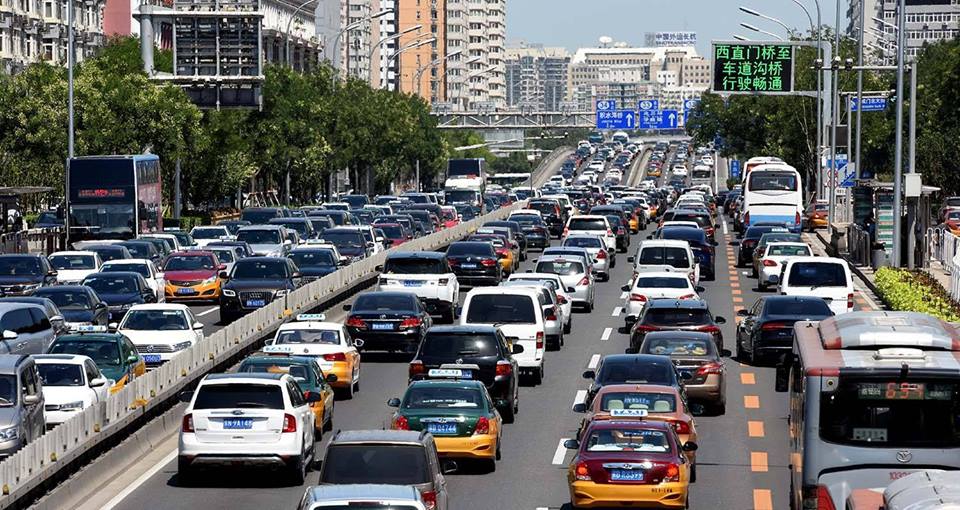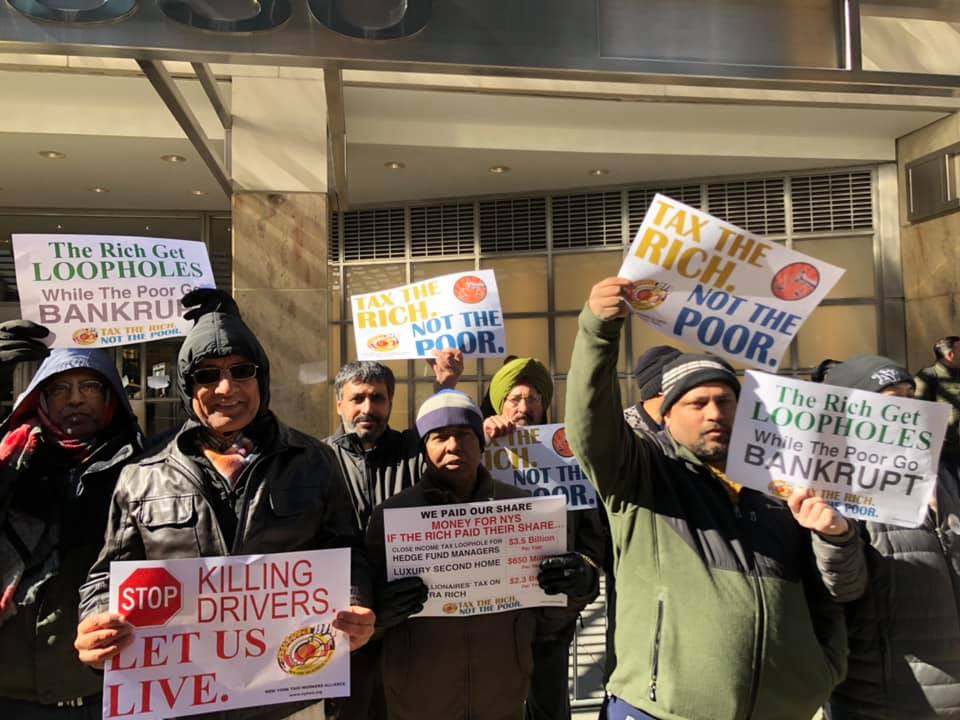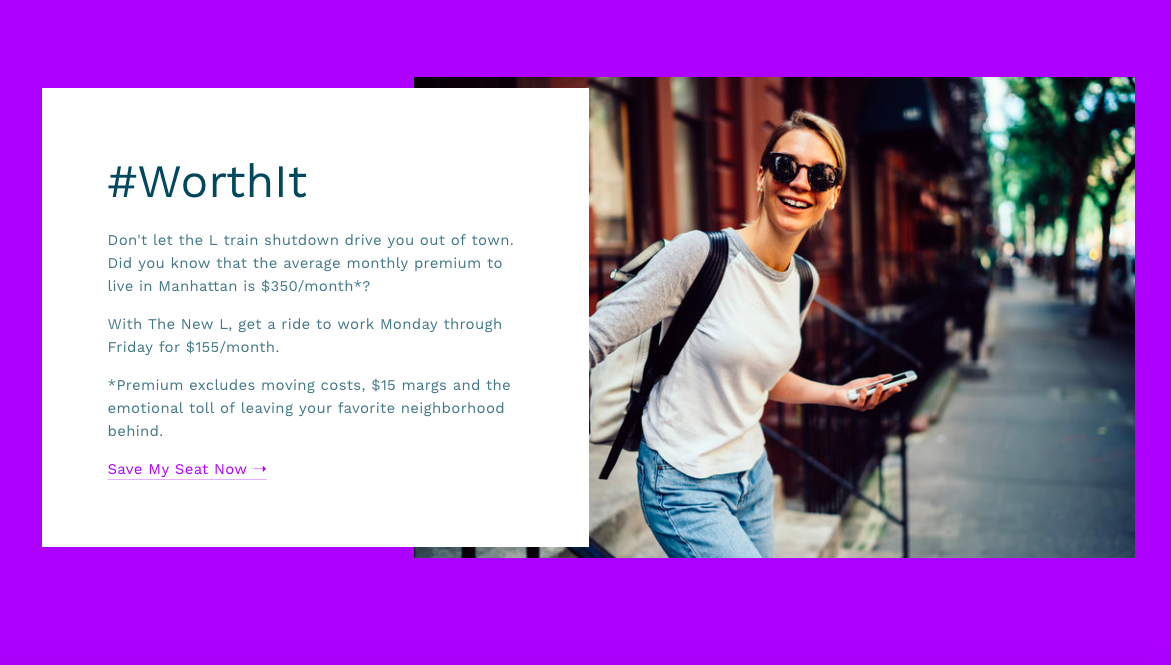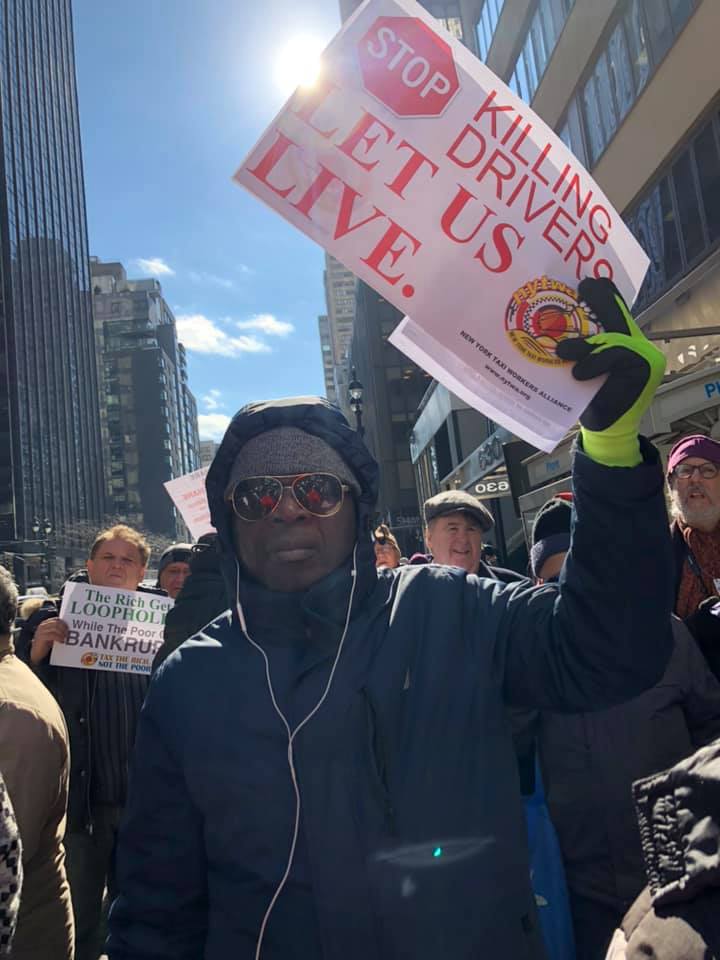Is Congestion Pricing the New Sweeping Regulation We Need?
"Tax the rich, not the poor!"
"No more tax on drivers' backs!"
"No more suicides! No more bankruptcy! Governor Cuomo, show us mercy!"
It was Wednesday March 20, and over 200 taxi drivers and their families had descended upon New York's capitol in Albany. They formed a boisterous motorcade, honked their horns while passersby took photos and videos. Then, they marched into the state capitol building and lined up along the building's sprawling, ornate "Million-Dollar Staircase."
They were there to protest congestion pricing that had gone into effect for taxi drivers starting in February. Congestion pricing, broadly, is a system that charges cars to enter city limits in hopes of limiting traffic. Per the rule, car services have to pay a $2.75 fee every time they enter and exit the area below 96th Street in Manhattan-where they see the majority of their business. However, ride-hailing services like Uber, Lyft, and Via lobbied to exempt themselves from that fee in situations where the customer requests a pool (even if no one else ends up joining the pool).
The New York Taxi Workers Alliance (NYTWA), which organized the action, said that this congestion fee could not have come at a more vulnerable time for taxi drivers. "The drivers are fired up and they're determined," Bhairavi Desai, co-founder of the alliance, said in a phone call. "Both out of necessity because the existence of the tax really will push thousands of them out of work, but also just a sense of dignity-that you know that this poverty isn't accidental nor of the drivers' own making, but it's a result of political machinations, primarily between the governor and Wall Street."
But their fight is up against an even larger movement. Much like San Francisco and Los Angeles, New York has tried to implement forms of congestion pricing since the 1970s. Now that the state has a Democratic-majority in the state legislature, experts are saying congestion pricing could come to allof New York on April 1, when the new budget is decided.
What happens in New York could set a precedent for the rest of the country, which is undergoing several, simultaneous debates about sweeping reforms amid the progressive "blue wave" that characterizes the left in 2019, from the Green New Deal to Medicare for All. If implemented correctly, congestion pricing, which has already reached cities like London and Stockholm could upend traffic flow and curb carbon emissions while funding the crumbling subway infrastructure.
But congestion pricing also means we risk hurting the working class when we try to mitigate climate change by addressing transportation. Think of the Yellow Vest protests in France: the protests were instigated by a fuel tax law intended to combat climate change. However, working class people argued that the tax was regressive. The scope of the protests gradually expanded to more general societal frustrations-specifically, the fact that lawmakers only try to improve society by taxing the poor.
The protests make it clear that the stakes for congestion pricing are high: if the state isn't careful to avoid the mistakes of its predecessors, we could alienate some of the most vulnerable people in our society and pose an undue burden on middle class people trying to get to get to their jobs.
What is congestion pricing?
Congestion pricing is a tax system that charges cars to enter the most congested parts of a city limits in hopes of limiting traffic. Cities that have implemented congestion pricing typically charge people more money for congestion-causing activities-like driving fuel-guzzling trucks, going to high-traffic areas in the heart of a city, or travelling during rush hour. Meanwhile, low-income individuals, emergency vehicles, or disability vehicles are typically exempt from these fees.
Congestion pricing is meant to address a few problems at once: climate change, urban infrastructure, and revenue gaps. Steering people away from emission-heavy cars and encouraging them to use public transportation system could help lower emissions within cities on a massive scale. Then, the money from the people who arepaying the fee can be used to fund improvements, such as New York's failing subway system, as Gov. Cuomo has proposed.
There's also an indisputable need to severely limit the number of cars on roads. A huge part of our climate problem can be traced back to cars and trucks, which emit 7 gigatonnes of CO2 annually, accounting for 72 percent of all transportation emissions globally, according to the UN's International Panel on Climate Change. That's more than the emissions from rail, oil pipelines, and aviation, and sea-shipping combined.
How congestion pricing has worked so far
Major global centers like London, Stockholm, and Singapore have all experimented with congestion pricing. Stockholm, Sweden, enacted congestion pricing in 2007 after a six-month trial period in 2006. William Eimicke, a professor of international and public affairs at Columbia University, told Motherboard in a phone call that Stockholm is largely a success story: congestion pricing targeted wealthier people, and it's raised money to refurbish its public transit. But of course, Stockholm is very different than New York.
"[Stockholm] is a model, but it's a model that has less relevance in New York because it's so much smaller, it's so much more homogenous, and the band between the inequality metric is very, very different," Eimicke said. "You have a much more equal society on almost every level. That's not all good, but in the case of something like transportation, it probably is good."
"It has to be well designed and well managed, but nobody should be expecting to be zipping around."
London, a closer comparison in terms of breadth and scale to New York, yields other lessons. Implemented in 2003, congestion pricing did bring the traffic down by 26 percent in the central part of the city in the first five years, according to the Centre for Public Impact, a nonprofit research organization funded by the Boston Consultant Group Foundation. It also reduced greenhouse emissions, and generated around $161 million in that span of time, funds which were then directed toward a more robust public transport system.
But London's system wasn't foolproof. Exempting ride hailing services from the tax, for example, backfired, and companies like Uber and Lyft led to a slow return to congested roads with 18,000 rides per day, according to city statistics. This not only crowded the streets, but also led to emptier public buses and bike lanes. The current mayor of London, however, has moved to now include for hire vehicles in the congestion pricing.
"I think the London approach illustrates two things that might sound oppositional: congestion pricing works but we shouldn't have outsized expectations of it," said Nicole Gelinas, a transportation researcher at the Manhattan Institute, a conservative think tank in a phone interview with Motherboard. "It has to be well designed and well managed, but nobody should be expecting to be zipping around."
And while the overall carbon emissions have gone down in all the case studies we have, a 2009 study from Rand, a nonprofit think tank, also found that the environmental benefits in the areas that are affected most by pollution and poor air quality had little to no improvement.
Several cities in China, such as Beijing and Hong Kong, have tried and failed to institute congestion pricing. Guo Dong, the Director of the Earth Institute China Initiative at Columbia University, told Motherboard in a phone call that congestion pricing has failed in China due to social attitudes about equity and fairness.
 Image: Traffic jam in Beijing, from Facebook.
Image: Traffic jam in Beijing, from Facebook. Guo told Motherboard in a phone call that people in China generally see congestion pricing as regressive when compared to, say, China's license plate lottery and alternating-plate system. China's license plate lottery caps the total number of cars that can be registered in a region, and does a lottery to determine who can get those plates. Its alternating plate system makes it so that onlylicense plates ending in even and odd digits, respectively, can enter cities like Beijing on certain days.
"People [in China] are generally opposed to giving more authority, more money to the government, so that can invite corruption, or mismanagement, those types of things," Guo said. "But with a lottery system, then it's really being controlled for everyone. So I think people think they're treated more fairly in that sense."
However, Guo said that measures like a license plate lottery and an alternating-plate system may not fly in the United States, because they could be perceived by Americans as infringing on their personal freedom.
"But I think over in China, people take the fairness and equity over maybe a little bit less personal freedom," Guo said. "They'd rather do that than give more money and create more administrative hustle. So I think in that sense, they're a little bit more lenient to the draconian measures."
What if congestion pricing comes to New York?
New York wants to be the first city in the country to have a well designed and well managed congestion pricing system, but the new proposed plan-which would target not just taxi drivers, but everyone-has garnered both support and fierce opposition.
 Image: NY Taxi Workers Alliance/Facebook
Image: NY Taxi Workers Alliance/Facebook Recently, Governor Andrew Cuomo and Mayor de Blasio joined forces and wrote a 10-Point Plan, which proposes using electronic tolling devices in Manhattan below 61st Street to charge vehicles during "peak travel hours." It specifies that people with disabilities or "identifiable hardship" would be exempt from this charge.
Crucially, the 10-point plan does not define exactly what constitutes "identifiable hardship," or specify exact figures on the fee and the times of peak travel hours. That's up for New York state legislators to decide. But the question of who is exempt from congestion pricing will make or break the measure as a whole in New York. Depending on how these "hardships" are defined, the state could target the rich, or disproportionately target low-income individuals.
According to the 10-Point Plan, congestion pricing would be instituted, ideally, by December 2020. But the decision of who is exempt and who is not will, for the most part, be outlined by April 1 when New York passes the annual budget. After all, the number of people paying the congestion price dictates how much money the measure will raise for the state.
The 10-Point Plan also introduces other methods of raising money for the subway, like "consolidating redundant functions" within the MTA (this could possibly mean layoffs), and combating fare evasion without criminalizing it. But in the past, combating fare evasion without "criminalizing" it often still meant an increased police presence in low-income communities of color-which are among the more likely populations to not be able to afford subway fares and be over-policed. In other words, combating fare evasion could put vulnerable bodies at risk.
New York City Mayor Bill de Blasio was previously against congestion pricing, and proposed raising a "millionaire tax" instead. When reached by Motherboard for comment, de Blasio's press team said he has become an advocate of congestion pricing, and a key supporter in the fight, since there's more support for the proposal. "Everyone knows, my ideal would have been a millionaires' tax," de Blasio said. "I've come to the conclusion that this moment there is not the support necessary for the millionaires' tax. I hope there will be in the future."
Danny Pearlstein, the director of policy and communications for the grassroots transit group Riders Alliance, told Motherboard that in a city like New York, congestion pricing makes a lot of sense. "In our view, congestion pricing is also fair," he said. "Congestion pricing would primarily charge very wealthy people to fix the subway, because you're talking about people who can afford to pay for parking in Manhattan."
That's no small win. New York City's subway system is in dire straits, and according to the Office of the Governor, it'll cost upwards of $22 billion in order to comprehensively improve the system. Subway tracks and tunnels around New York City are a century or more old, and falling apart. According to the New York Times, signal problems and train failures are twice as common as they were just 10 years ago, and 35 percent of all trips arrive late.
And as Pearlstein also noted that in New York, the highest income individuals tend to live in the heart of the city-the exact location where congestion pricing would take effect. He also said that low-income households and people of color disproportionately account for the people that rely on public transit in the city. Congestion pricing, he said, is a way of paying for the infrastructure improvements that will make public transportation more reliable for the people who need it most.
But critics say that's not true. "You cannot put blinders on when it comes to whose behavior you'll effect," Richard Brodsky, a former New York state assemblyman and lawyer and a critic of the law, told Motherboard. Brodsky, who says the tax should not be passed without a proper traffic study, said that it will impact middle income people the most. "Twelve dollars a day will not make a different to a Goldman Sachs banker but it will to the nurse or firefighter from Queens."
And according to the Rand study, if the revenue from congestion pricing is funneled toward everybody, instead of just lower income families, it will do little to solve for inequality. In fact, some people will be worse off than they were before. "These include people with no choice but to drive on congested routes with pricing in effect and those who may have to forgo important trips because they are too expensive," the authors wrote.
Private vs. Public
Some of this biggest drawbacks in congestion pricing implementation across the world has manifested when private companies replace public infrastructure.
Eimicke told Motherboard that he supports congestion pricing wholeheartedly. "It seems like a no brainer to me," Eimicke said. But he said the devil is in the details when it comes to congestion pricing. Its likelihood to succeed or fail depends on not just the exemptions, but the unintended consequences of limiting car-transportation.
He gave the example of people who need to use cars to travel into the city for work, or at least get to their nearest subway stop. What happens if you have to pay a congestion fee to get to that stop? The city could introduce more public buses, or van services. But the private sphere could step in and try to provide private van services.
That often leads to economic bias. For instance, consider when New York was planning for the L-train shutdown: a private, luxury car service The New L advertised "ultra-luxe commuter vans with professional chauffeurs." It would have cost $155 per month-almost $30 above the cost of a monthly, unlimited-ride metro card.
 Image: Screenshot from the New L website.
Image: Screenshot from the New L website.Eimicke said that we don't have adequate regulations on the taxi and car industry to protect people from private enterprises. "We have the Taxi and Limousine Commission, and we also have the MTA, we have people with expertise who do [regulations]," Eimicke said. "Do we have regulations in place right now? The answer is absolutely not. We don't even have the regulation in place to deal with the issue of cabs versus ride-share."
Julia Salazar, a freshman state representative, told Motherboard the proposed plan will help her constituents in north Brooklyn, most of whom are working class and rely on public transport. But she also supports an exemption for yellow cabs, which are a mix of public and private, and that have struggled to survive with the influx of ride hailing companies. "We need to examine what the actual impact would be on yellow cab drivers," she said in a phone call. "They're really at a disadvantage over for hire vehicles."
"It's not nuclear fission-we can figure out who the people are, and we could figure out solutions."
Desai from the NYWTA told Motherboard that the organization isn't against state-wide congestion pricing. But the NYWTA thinks that cab and taxi drivers should be exempt. Instead, Desai said, the state should make up that money by taxing New York's wealthiest residents. "We know that there's a growing consciousness in America around economic inequality, and a lack of taxes on wealthy, Desai said. "But we don't talk about overtaxation of the poor."
Desai also said that if the state relies on taxing the taxi industry to raise money, the taxi industry will continue to deteriorate. Over time, as more drivers come off the road, these measures won't raise as much money as the state anticipates.
It's likely that New York state legislators have considered the fact revenue from congestion pricing could decrease over time. After all, that means congestion pricing is working.It's designed to get cars off the road, meaning that over time, the state gets less money from cars paying those feeds.
Brodsky said that's where the congestion pricing tax will run into the most trouble. People who can't afford to pay the price will no longer have access to the city, which higher income people, for-hire vehicles and companies will. The revenue would be better off, he said, coming from a real estate tax, which is focused only on the wealthy.
"Supporters understand why this keeps running into trouble, it's because public officials understanding this stuff," he said. "This is public policy by concept. And by Twitter."
*
 Image: FacebookNY Taxi Workers Alliance/Facebook
Image: FacebookNY Taxi Workers Alliance/Facebook People who drive for a living are among the most vulnerable work forces in the country. Desai told Motherboard that taxi drivers, for instance, are sometimes the victims of hate crimes and are at a high risk of being in poverty. If implemented poorly, congestion pricing could dramatically add to the burden that drivers already bear.
Shortly after the taxi drivers gathered in Albany, another driver, who drove for Lyft, killed himself. Desai told Motherboard that eight New York City taxi drivers committed suicide in 2018, which was devastating for the community. It's clear that congestion pricing, for all of its potential to clear up our roads and air, will bear some of the responsibility for what happens to people driving in New York City-whether it's taxi drivers, Uber drivers, or the everyday commuter.
It will also put to test the public transport infrastructure options-be it trains, buses, bikes or scooters-that officials are hoping to extend. "It's not nuclear fission-we can figure out who the people are, and we could figure out solutions," Eimicke said. "Some of them are 70 years old, or they're 80 years old, and they're not gonna ride bikes. Some of them have disabilities. So, bike is part of a solution, but not the whole solution. Vans are part of the solution, but they're not the whole solution."
That leaves a city like New York in relatively uncharted waters, wrestling with the global problem that the individual vehicle has become.
"In the 1970s we were worried about pollution and we always thought to fix that problem by fixing traffic, but we didn't," said Gelinas. "The biggest solution now is a more reliable transit system."